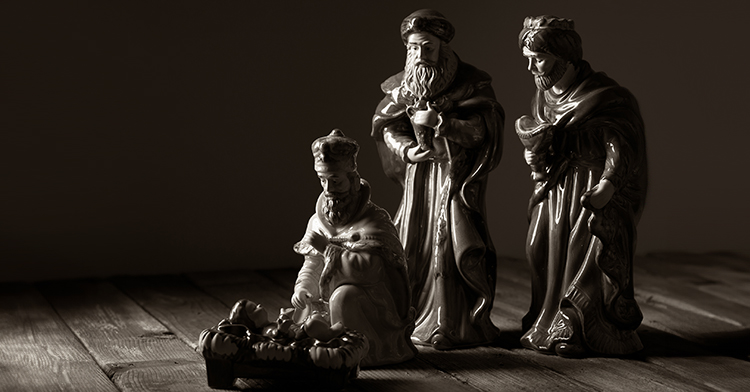In early October, as the days grow shorter and the leaves begin to fall, residents of Twin Lakes, a continuing care retirement community near Burlington, N.C., spring into action.
Sign-up sheets circulate among the 500 members who live independently; residents who want to bake cookies, greet guests or collect food items check off their chosen tasks and mark their calendars.
By the first of November, the holiday decorating shifts into high gear. Lighted trees are floated in the middle of two lakes; plywood nativity scenes are stationed along the road; and Santas and snowmen and reindeer and candy canes make their annual appearance up and down the lanes of the community’s 210-acre campus.
The frenetic activity is all part of the annual Lanes of Light, a one-mile drive-thru held the first weekend in December that has grown into the city of Burlington’s largest annual fundraiser for church-related food pantries.
This year, more than 8,000 people drove through the retirement community with their children, relatives and friends -- and often dogs. With each carload donating a bag of canned goods, some cash or a check, the event generated nearly 30 tons of food to benefit the city’s poor and homeless.
Commercial light shows have long been part of the Christmas tradition. Many are for profit and choreographed by professionals. Twin Lakes is neither, yet it manages to draw faithful crowds of holiday-goers, many of whom idle in their cars for more than 45 minutes for the chance to see a 60-foot sea serpent and an animated paddlewheel steamboat, among other illuminated creations.
That the glittery attraction is put on by the oldest and frailest segment of the city’s population is a testament to the magic of Christmas -- bringing hope and drawing gifts from society’s least-likely quarters.
At a time when elderly people are often viewed as a group needing help, the residents of Twin Lakes offer an example of how they can help others. Their example provides a glimpse of what God’s kingdom might look like if all contributed according to their abilities.
“There’s a lot to be said for age and wisdom,” said Kim Crawford, the executive director of Allied Churches of Alamance County, which, along with the Salvation Army, is one of the two beneficiaries of the event. “These people have been through life. And at the end of the day, they know the greatest joy you can get is serving other people. Wisdom is right here.”
When David Wall, the director of landscaping and grounds at Twin Lakes, strung multicolored Christmas lights on a 20-foot PVC pipe and hoisted it in the middle of one of the community’s lakes 10 years ago, he simply wanted to add to the residents’ holiday enjoyment.
“I just like people to stop and take notice,” he said.
He could hardly have imagined how that one floating Christmas tree would morph into 20, or how residents of the 30-year-old community would latch onto the concept by constructing their own handmade decorations.
At Twin Lakes, Christmas is a collaborative project.
While not all residents are motivated by faith, Twin Lakes brochures describe it as a “Christ-centered” community. Run by the nonprofit Lutheran Retirement Ministries of Alamance County, N.C., it was birthed after a Burlington couple -- Wade G. and Agnes Coble -- gave a $3.5 million bequest to Macedonia Evangelical Lutheran Church to establish health services for elderly people in Alamance County.
The suburban campus that was built on the edge of Elon University was the result of that bequest. It consists of cul-de-sac courts made up of brick homes, as well as interconnected complexes of apartment homes.
Each court or complex is named after a Christian religious figure (Aquinas, Calvin, Luther) or an important center of Christian thought (Aldersgate, Canterbury, Wittenberg).
In addition to its assisted living, health care and memory care facilities, Twin Lakes has a chapel, two columbaria, or memorial gardens, and a labyrinth.
This religious heritage is a source of comfort to many of the residents. On a bridge connecting the community’s central campus to its newest neighborhoods, a string of red lights proudly proclaims: “Jesus Is the Reason for the Season.”
During the two-day Lanes of Light event, many residents gather to sing carols.
“We emerged from the church, and we continue to develop ministries compatible with the church,” said Walter Ziegenhals, 84, a resident and a retired United Church of Christ minister.
But it may be the woodworking shop that has contributed the most to the Lanes of Light event’s success. Two dozen Twin Lakes residents work in the converted pony barn year-round, constructing large wooden objects that range from snowflakes and stars to penguins and bears, as well as traditional Santas and nativity scenes.
“The woodshop serves a very good purpose for people like me,” said Bill Cothran, 91, a resident who helps run the shop. “It keeps me busy.”
An opportunity to contribute
Thanks to medical science, Americans are living longer than ever before. Adults 80 and older are the fastest-growing segment of the population; many of them will spend their final years in one of the 2,000 continuing care retirement communities in the United States -- places such as Twin Lakes, where residents can transfer from independent housing to assisted living to a nursing home, all on the same campus.
Social workers, psychiatrists, health care workers and the children of these older adults are now beginning to grapple with ways to keep residents of such communities socially connected and meaningfully engaged.
Questions to consider
Questions to consider:
- What role do the elderly play in your organization?
- What groups of people from the body of Christ are under-
represented or underutilized in your work? How might they contribute to your organization? - In what ways does the article challenge your assumptions about community?
- What can Lanes of Light teach Christian leaders about the ways that Christian institutions can provide leadership in a particular community?
“One of the critical issues many older people face is that they’ve been givers all their lives, and now they’re receiving,” said Dan Blazer, a professor of psychiatry at Duke University who specializes in gerontology. “In some ways, it’s an uncomfortable feeling. Many older adults are looking for an opportunity to contribute.”
Blazer thinks older adults are an overlooked resource of volunteer labor and that religious congregations can and should do a better job of engaging them. While older adults may have health or cognitive limitations, there are many areas in which they excel. As a group, they tend to be reliable, hardworking and devoted. Many have been lifelong entrepreneurs and have a finely honed financial acumen.
Yet many congregations, anxious about their future and distracted by the latest church growth fads, routinely ignore them.
“A lot of pastors are focused on young families,” said the Rev. Patricia Suggs, a church coach and specialist in social gerontology based in Winston-Salem, N.C. “But older adults represent well over 50 percent of church membership, and if you exclude them, you’re missing out on a lot of knowledge, wisdom and capability.”
Retired people can offer churches assistance in countless ways, from performing routine clerical work to coaching younger married couples to tutoring school-age children.
It’s a message that’s particularly relevant at Christmas. If Jesus’ birth is about the incarnation -- God becoming flesh -- then human beings of all ages must be lifted up and allowed to contribute, regardless of limitation. Anything less is not the reign of God, said the Rev. Mark Menees, the senior director of pastoral services at Twin Lakes.
“A lot of people say the children are our future,” Menees said. “People here are our future as well. What they do here impacts the future.”
Susan Rhyne, 69, the Twin Lakes cookie maven, summed it up in a more practical way: “Just because we’re here doesn’t mean we’ll sit in a corner and do nothing.”
On a Friday in early December, Rhyne and her troop of bakers bagged 18,000 cookies. At the end of the Lanes of Light drive-thru, each driver is handed a clear zippered bag with four homemade cookies. Dogs get a biscuit from a box.
A well-oiled machine
Since that first floating Christmas tree was assembled in the middle of the lake more than 10 years ago, the Lanes of Light event has grown exponentially.
Today, seven years after it first opened to the public, the two-day event is a well-oiled machine.
From 5:30 to 9 p.m., residents wearing Santa hats and reflective orange safety vests over their coats and scarves stand at the opening of each court greeting the cars as they roll in.
Shouts of “Merry Christmas!” are exchanged as the cars slowly wind their way through the community, their windows rolled down, with the occasional child poking his head through the sunroof.
Portable music boxes tuned to a local station play holiday songs. Twin Lakes staff meander through the courts handing out hot cocoa or cider to keep residents warm.
“It gives folks a good feeling,” said Frances Underwood, 87, who baked six dozen sugar cookies and stood outside her home in 42-degree temperatures for more than an hour to greet the guests.
Highlights along the route include a lighted airplane, a covered bridge draped with brightly colored lights, and “Toyland,” a growing ensemble that includes a wooden firetruck, a circus wagon and a life-size jack-in-the-box. Each year, Faye Alexander, an 87-year-old resident, reprises her role standing in the box in a jester’s costume, her cheeks and nose painted with bright red dots.
“It’s so much more fun to be in this than to drive through,” said Alexander.
There’s no question Lanes of Light is a show. But it’s the goodwill it generates that keeps residents motivated.
“When I find an opportunity to be part of an organization that moves earnestly and with energy to do what they do here, I feel good about it,” said Ziegenhals, the retired UCC pastor. “I wouldn’t want to live in a place where those things are ignored.”
Serving God by serving other people
On Christmas Eve, many residents of Twin Lakes will gather in the May-Foley Chapel for Lessons and Carols followed by communion. A choir of 30 residents will sing. Others will attend Christmas Day services in churches across Burlington.
The festive lights will continue to flicker throughout the month of December.
Then by Jan. 2, Wall, the grounds director, will begin pulling down the illuminated creations and storing them in a couple of sheds on the property.
But that doesn’t mean the volunteer activities will cease. For the two dozen woodworkers, next year’s event has already begun. There are old installations to repair and new designs to draw, cut, build and paint.
Bill Cothran, who will celebrate his 92nd birthday Jan. 19, keeps photos of the woodworking projects he and other residents have worked on. He’s pasted them on a poster board he keeps in his home: benches, bookcases, birdhouses, cabinets, tables and wheelchair ramps.
“It keeps me feeling it’s worth it for the Lord to keep me here,” said Cothran, who is Presbyterian.
A retired hosiery industry executive, Cothran never used a table saw or a nail gun before he moved to Twin Lakes.
But soon after arriving here 17 years ago, he found himself with extra time and plenty of people willing to teach him. He’s kept at it since the death of his wife seven years ago.
Woodworking, Cothran said, is one way he can still give back: “You serve God by serving the needs of other people,” he said. “My goal is to help somebody every day.”









